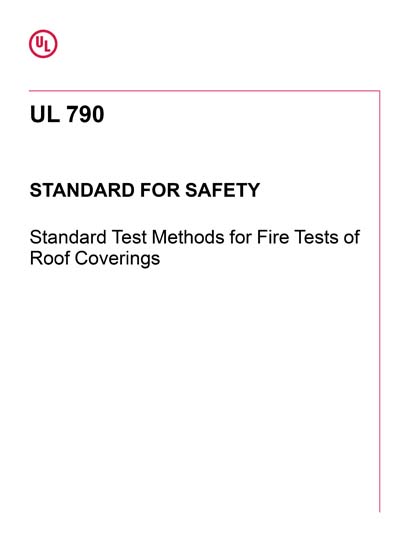Most recent
UL 790 Ed. 9-2022
Standard Test Methods for Fire Tests of Roof Coverings
1.1 These requirements cover the measurement of the relative fire characteristics of roof coverings exposed to simulated fire sources originating from outside a building on which the coverings are installed. They are applicable to roof coverings intended for installation on either combustible or noncombustible roof decks (see 4) when the roof coverings are applied as intended. The following test methods are included: a) Intermittent-Flame Exposure test; b) Spread of Flame test; c) Burning Brand test; d) Flying Brand test; and e) Rain test. 1.2 Three classes of fire exposure are described. a) Class A roof coverings that are expected to be effective against severe fire exposures. Under such exposures, roof coverings of this class afford a high degree of fire protection to the roof deck, do not slip from position, and are not expected to produce flying brand. b) Class B roof coverings that are expected to be effective against moderate fire exposures. Under such exposures, roof coverings of this class afford a moderate degree of fire protection to the roof deck, do not slip from position, and are not expected to produce flying brand. c) Class C roof coverings that are expected to be effective against light fire exposures. Under such exposures, roof coverings of this class afford a light degree of fire protection to the roof deck, do not slip from position, and are not expected to produce flying brand. 1.3 Tests conducted in accordance with these requirements are intended to demonstrate the performance of roof coverings during the types and periods of fire exposure involved, but are not intended to determine the acceptability of roof coverings for use after exposure to fire. These fire test methods do not provide a basis to compare expected performance under all actual fire conditions but they do provide a basis for comparison of the response of roof coverings when subjected to fire sources that are described herein. 1.4 These test methods address roof coverings used over both combustible and noncombustible decks. A combustible deck is generally constructed using materials that do not comply with the requirements of ASTM E136, such as wood sheathing boards, oriented strand boards (OSB), or plywood. A noncombustible deck is generally constructed entirely of materials that comply with the requirements of ASTM E136, such as metal, concrete, or poured gypsum.
Underwriters Laboratories [ul]

